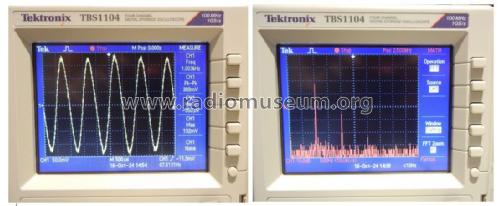- Produttore / Marca
- Freed-Eisemann Radio Corp.; New York, NY
- Anno
- 1925
- Categoria
- Radio (o sintonizzatore del dopoguerra WW2)
- Radiomuseum.org ID
- 40946
Clicca sulla miniatura dello schema per richiederlo come documento gratuito.
- Numero di tubi
- 5
- Valvole
- Principio generale
- A circuiti accordati (TRF o amplif. diretta in generale); Neutrodina (con neutrocondensatore)
- N. di circuiti accordati
- 3 Circuiti Mod. Amp. (AM)
- Gamme d'onda
- Solo onde medie (OM).
- Tensioni di funzionamento
- Batterie (di accumulatori e/o a secco)
- Altoparlante
- - Per cuffie o amplificatori esterni
- Materiali
- Mobile in legno
- Radiomuseum.org
- Modello: FE15 - Freed-Eisemann Radio Corp.;
- Forma
- Soprammobile a cassapanca o cassetta, solitamente con coperchio (NON a leggio)
- Dimensioni (LxAxP)
- 19 x 9.5 x 9.5 inch / 483 x 241 x 241 mm
- Annotazioni
- Three dials (primary tuning control knobs)
- Prezzo nel primo anno
- 75.00 $
- Fonte esterna dei dati
- Ernst Erb
- Fonte dei dati
- Radio Collector`s Guide 1921-1932
- Riferimenti schemi
- Rider's Perpetual, Volume 1 = 1931/1934 (for 1919-1931)
- Bibliografia
- Collector's Guide to Antique Radios 4. Edition
- Letteratura / Schemi (1)
- Radio Manufacturers of the 1920's, Vol. 2
- Altri modelli
-
In questo link sono elencati 205 modelli, di cui 106 con immagini e 128 con schemi.
Elenco delle radio e altri apparecchi della Freed-Eisemann Radio Corp.; New York, NY
Collezioni
Il modello FE15 fa parte delle collezioni dei seguenti membri.
Discussioni nel forum su questo modello: Freed-Eisemann Radio: FE15
Argomenti: 1 | Articoli: 1
Receiver sensitivity was measured with Rohde & Schwarz SM300 signal generator with the adaptor for long wire antenna, connected to long wire antenna input of the radio.
The sensitivity is around -55 dBm at 1 MHz with a very good (S+N)/N ratio of more than 10 dB. The signal goes in the noise level at around -70 dBm. Even signals around -60 dBm still audible, with a reasonable (S+N)/N ratio. At 550 kHz the sensitivity is also -55 dBm, at 1200 kHz around -50 dBm and at more than 1300 kHz up to 1650 kHz around -45 dBm. The reduced sensitivity at higher frequency is related to the loss of selectivity (variation of variable capacitance versus the degree of rotation of tuning knobs).
RF Bandwidth
3 dB RF bandwidth is around 5 kHz, when perfectly tuned at middle of the BC band. Measurements were performed at 1 MHz, 1 kHz modulated signal, 75 % modulation index, -50 dBm input power at the long wire input connector. Please see the measurement photos.
Tuning can be very sharp. However, in order to increase the RF bandwidth, the tuning capacitors can be misaligned a bit, especially when listening the music. Very sharp tuned is recommended for voice only.
AF Distortions
The AM modulation uses 1 kHz tone, modulation index 75%. The oscilloscope, connected at the horn output display the demodulated signal. Measurements on the oscilloscope display shows also 1 kHz with a 0.3 % combined transmitted frequency and measurement error, as seen in the left oscilloscope screen photo.
Using the FFT function of the equipment we can measure that the 2nd harmonic is almost 25 dB lower than the fundamental tone, almost a perfect sinusoidal shape.
AF Bandwidth
The 6 dB AF bandwidth for sharp tuning is 1.4 kHz (500 Hz – 1900 Hz) and the cutting frequency is 3 kHz. The carrier and two side bands of AM is only around 4 kHz, and it is almost as wide as the 3dB RF bandwidth (5 kHz). Of course this has a big impact on the audition, the voice is advantaged versus the music.
This was normal in the horn speaker era when audio signals of more than 2.5 kHz were not reproduced properly.
Allegati
Serioja Tatu, 26.Oct.24






























